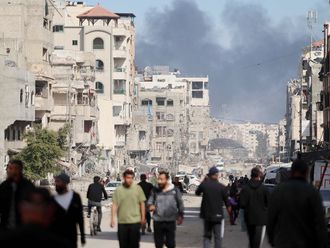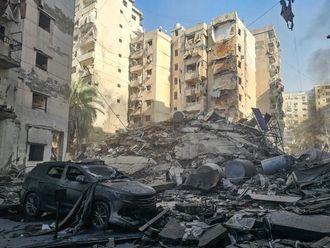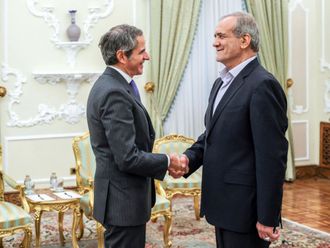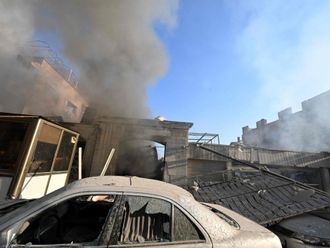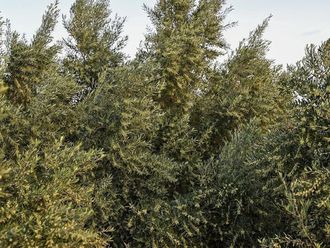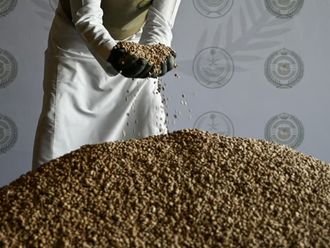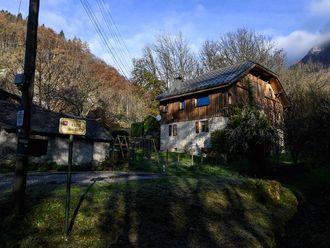April 18, 2010: US and Iraqi forces kill two top leaders of Al Qaida’s branch in Iraq. Abu Bakr Al Baghdadi becomes the terror group’s new leader.
March 2011: Syrian conflict erupts following an uprising against President Bashar Al Assad that turns into an insurgency and eventually civil war, attracting scores of Al Qaida militants from Iraq.
April 2013: Al Baghdadi announces his group has taken over Al Nusra Front, the Al Qaida affiliate in Syria. The combined group is variously called the Islamic State of Iraq and the Levant, or Isil, eventually it is known as the Islamic State (Daesh). Al Nusra denies the takeover, sparking infighting that continues to this day.
March 5, 2013: Rebel factions including Al Nusra Front take over Raqqa, a provincial capital in north-central Syria, the largest city to be wrested from Al Assad’s government by rebels.
May 2013: Daesh fighters burst on stage and show their strength by shooting three people in a main square in Raqqa. The group begins seizing towns and villages across northern Syria.
January 2014: Al Baghdadi’s forces sweep into Fallujah and parts of Ramadi in Iraq’s Al Anbar province, which Iraqi security forces had abandoned weeks earlier. In Syria, they seize full control of Raqqa after driving out rival groups. Infighting with rivals erupts across north and eastern Syria.
June 10, 2014: Al Baghdadi’s fighters take over Iraq’s second-largest city of Mosul and, the next day, overrun more of Nineveh province, including the village of Eski Mosul. They soon sweep south, capturing Saddam Hussain’s hometown of Tikrit and much of the Sunni heartland nearly to the outskirts of Baghdad as government forces melt away. When they threaten Shiite holy sites, Iraq’s top Shiite cleric issues a call to arms against the group, bringing a flood of volunteers to militias.
June 29, 2014: Daesh declares the establishment of a “caliphate,” or Islamic state, in territories it controls in Iraq and Syria, and Al Baghdadi is declared the caliph. The militants rename themselves the “Islamic State”. To celebrate, they “unite” the territories by knocking down sand berms in the desert that mark the border between the two countries. They soon after seize several actual border crossings.
Aug 8, 2014: The US begins targeting Daesh with air strikes, citing the humanitarian plight of Iraq’s minorities, like the Yazidis.
Aug 19, 2014: Daesh releases a video showing the beheading of American journalist James Foley in response to the US-led air strikes. This marks the first of many videos showing terrorists beheading foreign captives.
Jan 23, 2015: Kurdish Peshmerga fighters regain control of Eski Mosul and several neighbouring towns, driving out Daesh fighters.
Jan 26, 2015: Kurdish fighters take control of the Syrian border town of Kobani near Turkey after fighting Daesh terrorists for months. US-led air strikes helped turn the tide for the Kurds.
Feb 3, 2015: Daesh releases a video of Jordanian pilot Muath Al Kaseasbeh being burnt to death inside a cage.
April 1, 2015: Backed by US-led coalition air strikes, Iraqi forces retake the city of Tikrit, their biggest gain yet against Daesh.
May 17, 2015: Ramadi, the capital of Iraq’s Al Anbar province, falls to Daesh as Iraqi forces abandon their weapons and armoured vehicles to flee.
May 20, 2015: Daesh captures the historic desert city of Palmyra in central Syria after Al Assad’s forces collapse and withdraw.
June 16, 2015: Kurds deal Daesh a major setback by capturing the Syrian town of Tal Abyad on the Turkish border, which had provided a strategic supply route to Daesh.


